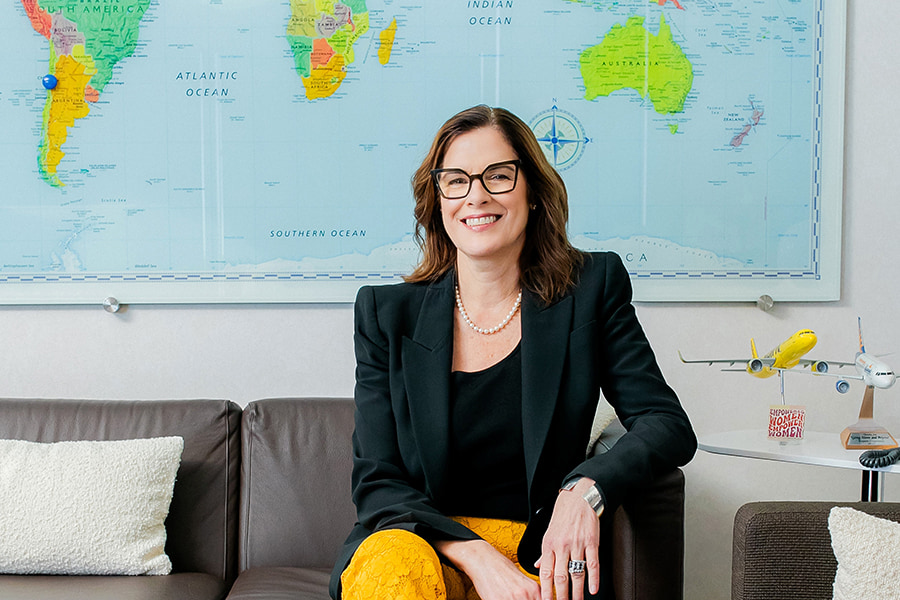- Home
- News
- Recent News
- Sky’s the Limit: Christina Cassotis ’94 Takes Pittsburgh to New Heights
Sky’s the Limit: Christina Cassotis ’94 Takes Pittsburgh to New Heights
On a cold January morning in 2015, Christina Cassotis ’94 walked into Pittsburgh International Airport (PIT) with a vision, a plan—and more than a few skeptics quietly watching her every move.

The airport was a shell of its former self. Once a bustling hub for a major airline, it had become eerily quiet, its soaring terminals half-used, and its passengers dwindling. Most people saw an aging facility left behind by the airline industry. Cassotis, however, saw a blank canvas and a world of opportunity.
“I didn’t come to run an airport,” she said. “I came to change an industry.”
What followed was less of a turnaround and more of a renaissance. Over the next decade, Cassotis led a transformation that positioned Pittsburgh International as a global leader in sustainability, innovation, and community investment.
Under her leadership as CEO of the Allegheny County Airport Authority, the airport earned a reputation as one of the most forward-thinking in the world. It became the first airport inducted into the Aviation Hall of Fame. PIT has repeatedly been named an airport of the year, including by Air Transport World and the CAPA Centre for Aviation. It was ranked among Fast Company’s Most Innovative Companies in the World and featured in Condé Nast Traveler’s Bright Ideas in Travel list. Additionally, PIT received national recognition from the White House for PIT2Work, the airport’s workforce development initiative.
Cassotis didn’t just modernize the airport. She redefined it.
Her path to becoming one of the most influential figures in airport leadership didn’t follow a traditional flight path. After deliberately flunking out of college—“I got seven F’s and a B-plus,” she laughed—Cassotis spent several years bartending, waitressing, and even volunteering as a counselor for survivors of domestic violence.
Eventually, she found her way to UMass Boston.
“UMass Boston gave me a chance when nobody else would,” she said. “I was living in the city, bartending on Beacon Hill, and when I decided to go back to school, I knew I wanted to study what I loved: English. One of my best friends in the world, I met in a writing class there. We still talk three times a week.”
Cassotis grew up in Londonderry, NH, a small town known for its plentiful apple orchards. She credits her father—a commercial airline pilot who flew international routes for decades—with sparking her love for aviation.
“When I was 10, my parents took my brother and me to London. I remember feeling like the whole world had opened up, and I thought, ‘I want this. I want to see the world,’” she said. Though she knew early on that she didn’t want to be a pilot herself, it wasn’t until working at the Massachusetts Port Authority that she realized airports could be her entry point into the industry.
“At Massport, I’d sit on my break and just watch people, wondering where they were coming from or going to,” she said. “I loved it.”
That realization led to a 17-year career in aviation consulting, a master’s from MIT, and, eventually, the top job at Pittsburgh International. But when she arrived, she faced a community still longing for the return of its hub operations.
“People in Pittsburgh felt that success meant being a hub, because that’s what they had known,” she recalled. “But I knew that wasn’t coming back. I told the board I’d only take the job if they were okay with that.”
They were. And Cassotis got to work.
Over the next 10 years, she introduced sweeping changes. Pittsburgh International became home to the first microgrid in the world that fully powers an airport using natural gas and solar energy. She launched xBridge, an in-terminal innovation lab where start-ups can test new tech in a real-world environment. Amenities like a sensory-friendly room for travelers with special needs, a childcare center for employees, and the Neighborhood 91 additive manufacturing campus redefined what an airport could offer—not just for its passengers, but for the community and its economy.
“To me, it’s a natural output of a culture that is always asking: ‘What else can we do?’ and ‘Why not?’ or ‘What if?’” Cassotis said.
Among all of Cassotis’s achievements, her proudest moment is still on the horizon: a new $1.7 billion terminal, set to open in late 2025. Cassotis said the facility reflects years of persistence, even in the face of a global pandemic that threatened to derail it all.
“When COVID hit, we had half of the necessary airline signatures we needed to move the project forward. And then we had none. But we kept designing anyway. I believed travel would come back. We bet on ourselves—and it paid off.”
The terminal’s sustainable, passenger-first design represents an architectural upgrade. Not only will it consolidate all check-in, ticketing, security, and baggage operations into one facility, but the project also includes additional space for concessions, an expanded TSA checkpoint, and a new parking garage.
“This industry has needed a kick in the pants,” Cassotis said. “And I would say that’s exactly what we’ve done.”